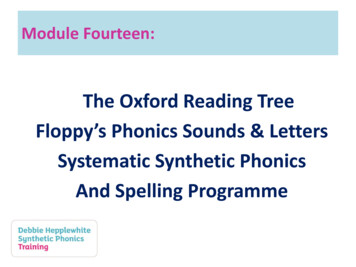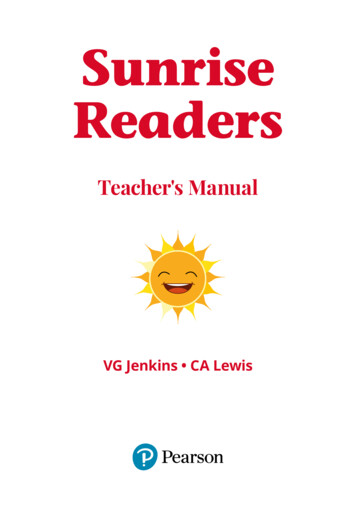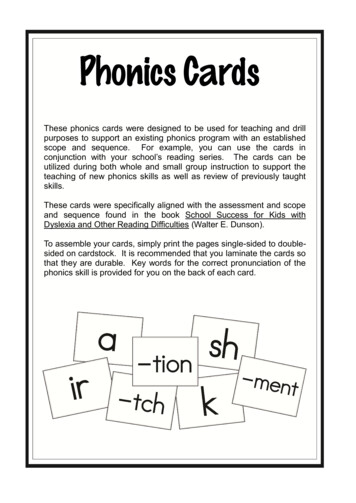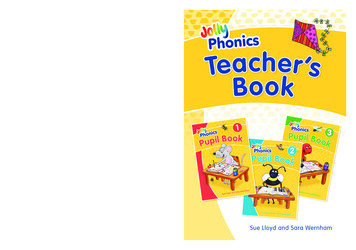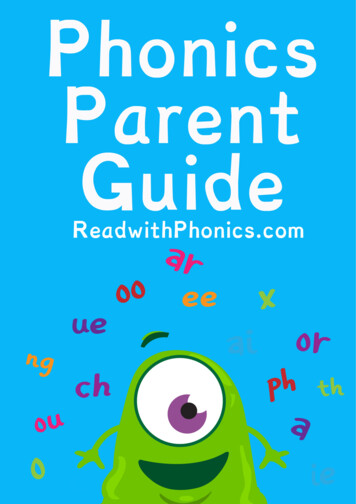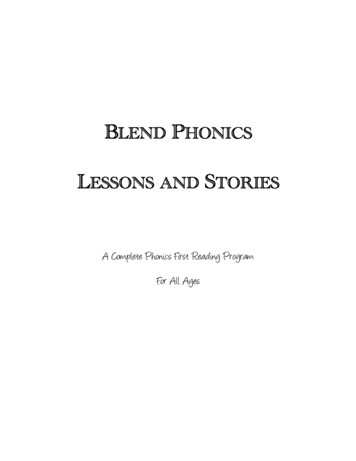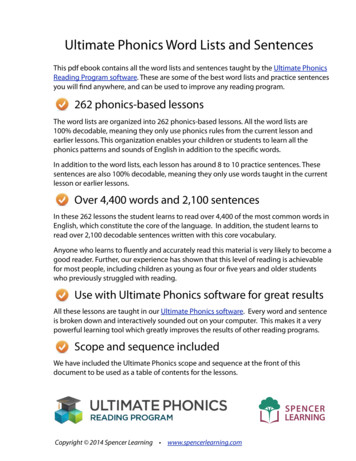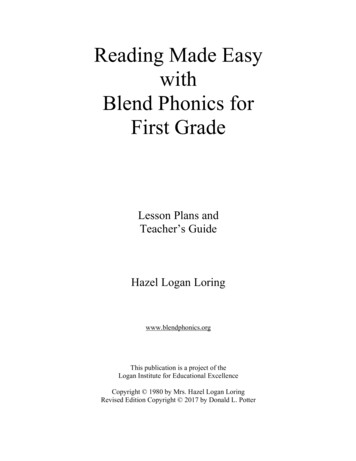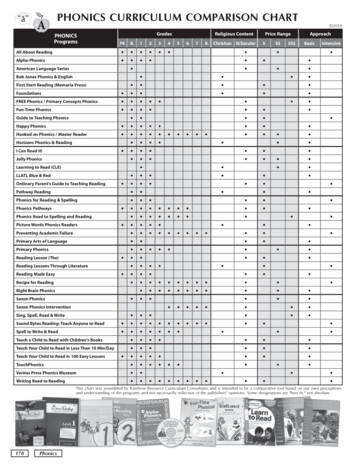
Transcription
Phonics: Theory and PracticeChing Kang LiuNational Taipei UniversityI. Need AnalysisDo our students need instruction of phonics?Students:1. What do our students want to learn?2. Do our students need to learn phonics?3. What can phonics contribute to our students’ learning of English?4. Will phonics help our students improve reading ability?Teachers:1. Do I know very well about the function of phonics?2. What do we want to teach our students through phonics?2. Can I remember all the rules of phonics?3. Do I know very well the role of phonics in my instruction?4. Do I really know for sure that phonics help my students improve reading ability?II. What is phonics?Phonics refers to associating letters or letter groups with the sound they represent.(1)Phonics is the system of teaching reading that builds on the alphabetic principle, asystem of which a central component is the teaching of correspondences betweenletters or groups of letters and their pronunciations (Adams, 1994).In other words, phonics refers to associating letters or letter groups with the soundthey represent.(2)Phonics refers to a method for teaching speakers of English to read and write thatlanguage. Phonics involves teaching how to connect the sounds of spoken English withletters or groups of letters (e.g., that the sound /k/ can be represented by c, k, ck, or chspellings) and teaching them to blend the sounds of letters together to produceapproximate pronunciations of unknown words.Therefore, phonics is not necessarily a method for teaching English pronunciation;it is a method for teaching English speakers to read and write.III. Why Phonics?Because of the complexity of written English, more than a century of debate hasoccurred over whether English phonics should or should not be used in teachingbeginning reading.1
Despite the work of 19th century proponents such as Rebecca Smith Pollard,some American educators, prominently Horace Mann, argued that phonics should notbe taught at all. This led to the commonly used "look-say" approach ensconced in the"Dick and Jane" readers popular in the mid-20th century.Beginning in the 1950s, however, phonics resurfaced as a method of teachingreading. Spurred by Rudolf Flesch's criticism of the absence of phonics instruction(particularly in his popular book, Why Johnny Can’t Read, 1955) phonics resurfaced.IV. Whole LanguageIn the 1980s, the "whole language" approach to reading further polarized thedebate in the United States. Whole language instruction was predicated on theprinciple that children could learn to read given(a) proper motivation,(b) access to good literature,(c) many reading opportunities,(d) focus on meaning, and(e) instruction to help students use meaning clues to determine the pronunciation ofunknown words.For some advocates of whole language, phonics was antithetical to helping newreaders to get the meaning; they asserted that parsing words into small chunks andreassembling them had no connection to the ideas the author wanted to convey.The whole language emphasis on identifying words using context and focusingonly a little on the sounds (usually the alphabet consonants and the short vowels) couldnot be reconciled with the phonics emphasis on individual sound-symbolcorrespondences.Thus, a dichotomy between the whole language approach and phonics emerged inthe United States causing intense debate. Ultimately, this debate led to a series ofCongressionally-commissioned panels and government-funded reviews of the state ofreading instruction in the U.S.In 1984, the National Academy of Education commissioned a report on the statusof research and instructional practices in reading education, Becoming a Nation ofReaders. Among other results, the report includes the finding that phonics instructionimproves children’s ability to identify words. It reports that useful phonicsstrategies include teaching children the sounds of letters in isolation and in words, andteaching them to blend the sounds of letters together to produce approximatepronunciations of words. It also states that phonics instruction should occur inconjunction with opportunities to identify words in meaningful sentences andstories.In 1990, Congress asked the U.S. Department of Education to compile a list ofavailable programs on beginning reading instruction, evaluating each in terms of theeffectiveness of its phonics component. As part of this requirement, the US DOEasked Dr. Marilyn J. Adams to produce a report on the role of phonics instruction inbeginning reading, which resulted in her 1994 book Beginning to Read: Thinking andLearning about Print. In the book, Adams asserted that existing scientific researchsupported that phonics is an effective method for teaching students to read at the word2
level. Adams argued strongly that the phonics and the whole language advocates areboth right. Phonics is an effective way to teach students the alphabetic code, buildingtheir skills in decoding unknown words.By learning the alphabetic code early, Adams argued, students can quickly free upmental energy they had used for word analysis and devote this mental effort tomeaning, leading to stronger comprehension earlier in elementary school. Thus, sheconcluded, phonics instruction is a necessary component of reading instruction, butnot sufficient by itself to teach children to read. This result matched the overall goal ofwhole language instruction and supported the use of phonics for a particular subset ofreading skills, especially in the earliest stages of reading instruction. Yet theargument about how to teach reading, eventually known as "the Great Debate,"continued unabated.The National Research Council re-examined the question of how best to teachreading to children (among other questions in education) and in 1998 published theresults in the Prevention of Reading Difficulties in Young Children (Catherine Snow,et. al.). The National Research Council’s findings largely matched those of Adams.They concluded that phonics is a very effective way to teach children to read at theword level, more effective than what is known as the "embedded phonics" approachof whole language (where phonics was taught opportunistically in the context ofreading materials). They found that phonics instruction must be systematic (followinga sequence of increasingly challenging phonics patterns) and explicit (teachingstudents precisely how the patterns worked, e.g., "this is b, it stands for the /b/sound") .In 1997, the National Reading Panel examined quantitative research studies onmany areas of reading instruction, including phonics and whole language. Theresulting report Teaching Children to Read: An Evidence-based Assessment of theScientific Research Literature on Reading and its Implications for Reading Instructionwas published in 2000 and provides a comprehensive review of what is known aboutbest practices in reading instruction in the U.S. The panel reported that several readingskills are critical to becoming good readers: phonics for word identification, fluency,vocabulary and text comprehension. With regard to phonics, their meta-analysis ofhundreds of studies confirmed the findings of the National Research Council:teaching phonics (and related phonics skills, such as phonemic awareness) is a moreeffective way to teach children early reading skills than is embedded phonics orno phonics instruction.V. Who needs phonics?Buried deep in Johnson's article is the suggestion that some children can acquirephonics generalizations by reading. As noted earlier, Smith (e.g. 1994) hashypothesized that most of our knowledge of phonics is the result of reading and notthe cause (Krashen, 2002).Johnson's view differs somewhat from Smith's in that she claims that somechildren can indeed acquire sound-spelling correspondences by reading, while others"need systematic instruction" (p. 141). No evidence is provided for this extremelyimportant claim, a claim that runs counter to current official state and federal3
government policy that all children must have systematic, intensive phonicsinstruction (Krashen, 2009).To support such a claim, one would have to show that there are substantialnumbers of children who have learned to read without extensive phonics training (thisis easy to find), and also substantial numbers of children who cannot "learn to read byreading," who require extensive phonics instruction. The existence of this secondgroup has never been demonstrated: To do so, one must find large numbers of childrenwho have been read to, who have substantial exposure to comprehensible andinteresting texts, and who nevertheless fail to learn to read (Krashen, 2002).Reconsider:Intensive phonics instruction (reading-like behavior)Intensive, Systmatic Phonics—all major letter-sound correspondences taught inorder—assumes(1) we learn to read by first learning the rules of phonics, that is, we learn to readby sounding out words and reading out-loud ("decoding to sound").(2) knowledge of phonics must be deliberately taught and consciously learned.This is hard work. The major rules (Ehri): "long and short vowels and vowel andconsonant digraphs consisting of two letters representing one phoneme, such as oi, ea,sh, and th. Also, phonics instruction may include blends of letter sounds that representlarger subunits in words such as consonant pairs (e.g. st, bl), onsets, and rimes" (p.180)(Cited by Krashen, 2009)Basic phonics instructionBasic Phonics: It is helpful to teach some rules of phonics, only the straight-forwardrules.Basic phonics instruction assumes(1) we learn to read by reading, by understanding what is on the page.(2) Most of our knowledge of phonics is the result of reading; more complex rules ofphonics are subconsciously acquired through reading (Smith).(3) Basic rules can help by making texts more comprehensible, restrictingpossibilities:Smith: "The man was riding on the h ." and cannot read the final word.Zero Phonics: all phonics rules can be acquired by reading. Rare.VI. Strengths of phonicsPhonemic Awareness1. Phonemic awareness instruction is more effective when students are taught to useletters to manipulate phonemes.2. Explicit phonemic awareness instruction helps beginning readers and those havingreading difficulties.3. Explicit phonemic awareness instruction helps preschoolers, kindergartners, andfirst graders learn to spell.4
Phonics1. Phonics instruction improves word reading skills, especially for kindergartners,first graders, and older struggling readers.2. Explicit, systematic phonics instruction is significantly more effective thanalternative programs providing nonsystematic or no phonics instruction.3. Explicit phonics instruction is significantly more effective than nonsystematicphonics instruction with children of different ages, abilities, and socioeconomicbackground.VII. Limitation of phonics1. Learn to read letters or learn to read words?2. Too many rules that even teachers cannot remember all.3. Even if these rules were remembered, "not only is the system massive and complex,it is also unreliable, because it contains no way of predicting when a particularcorrespondence applies. What is the use of a complex set of rules if there is noreliable guide for when a particular rule should be employed?" (Frank Smith,2005).4. When readers meet new words, they guess the meaning first, and then try to soundthe word out. But phonics does not help children to "guess the meaning" but try to"sound out" words first.5. Very basic rules of phonics will help students figure out how to "read out" thewords, but if these students did not speak the language in advance, they wouldn’t beable to know the meaning of the words sounded out. Then what the use of phonicrules?VIII. Issues to ponder1. Do we need phonics for our students? Do we really understand our students’ need?2. When teaching phonics, do we teach “decoding of words”? Or “the meaning of theword”? Or “Pronunciation” for communication”? Or just teach “whatever has beenassigned to teach”?3. How can we apply phonics to our instruction of reading?(1) Synthetic phonics(2) Analytical phonics(3) Analogy phonics(4) Embedded phonicsIX. A combined approachMany school systems, such as California's, have made major changes in themethod they have used to teach early reading. Today, most teachers combine phonicswith the elements of whole language that focus on reading comprehension. They areemploying a combined approach Adams (1994) and the National Reading Panel (1994)advocate for a comprehensive reading program that includes several different subskills.This combined approach is sometimes called balanced literacy. Some researchers(Moats, 2008) assert that balanced literacy is merely whole language called by anothername.5
Proponents of various approaches generally agree that a combined approach isimportant.See also Liu, C. K. (2005). Phonics & K. K. and children's English pronunciation.English Works (20), 22-24.Phonics RulesI. Here are the most commonly used phonics rules:1. Every syllable in every word must contain a vowel. The vowels are: a, e, i, o, u, andy (although y is a consonant when at the beginning of a word).2. When "c" is followed by "e, i, or y," it usually has the soft sound of "s." Example:city.3. When "g" is followed by "e, i, or y," it usually has the soft sound of "j." Example:gem.4. A consonant digraph is two or more consonants that are grouped together andrepresent a single sound. Here are consonant digraphs you should know: wh (what),sh (shout), wr (write), kn (know), th (that), ch (watch), ph (laugh), tch (watch), gh(laugh), ng (ring).5. When a syllable ends in a consonant and has only one vowel, that vowel is short.Examples: tap, bed, wish, lock, bug.6. When a syllable ends in a silent "e," the vowel that comes before the silent "e" islong. Examples: take, gene, bite, hope, fuse.7. When a syllable has two vowels together, the first vowel is usually long and thesecond vowel is silent. Example: stain.8. When a syllable ends in a vowel and is the only vowel, that vowel is usually long.Examples: ba/ker, be/come, bi/sect, go/ing, fu/ture, my/self.9. When a vowel is followed by "r" in the same syllable, the vowel is neither long norshort. Examples: charm, term, shirt, corn, surf.6
II. Clymer’s 45 phonic generalizations7
8
9
III. Other formats to present the rulesVowel A1. ( )a —(be pronounced as a “short” vowel)catdadgasratatasad2. ( )a e—(be pronounced as a “long” vowel)date case latesake page ateage3. ( )ai —(be pronounced as a “long” vowel)wait rain jailpaid failaidaim (said)4. ( )ay( ) —(be pronounced as a “long” vowel)saydaypayway days pays gays (says)5. ( )al —(be pronounced as / /)allcallsalttallmall ballwall6. ( )aul —(be pronounced as / / and “u” is silent)fault Paul7. ( )aught—(be pronounced as / / and “ugh” is silent)caughttaught daughter8. ( )aw( )—(be pronounced as / / and “w” is silent)saw lawjawclaw dawn lawn9. ( )ar( )—(be pronounced as / /)hard bark cartcarbarjar10. ( )are —(be pronounced as / /)care hare dare ware rare share11. ( )air( )—(be pronounced as / /)airhair pair fairchair12. ( )a( )ion—(be pronounced as “long” vowel)station vacationoccasionVowel E1. ( )e —(be pronounced as a “short” vowel)bedletgetsetredpetnet2. ( )e e—(be pronounced as a “long” vowel)evethese delete impedePete complete3. ( )ee( )—(be pronounced as a “long” vowel)seebeemeet keep need week sleep4. ( )ea( ) —(be pronounced as a “long” vowel)eatmeat real lead team teamean (great, head, instead)5. c/sei( )—(be pronounced as /i/ and “i” is silent)receiveseize deceiveceiling6. ( )ew( )—(be pronounced as / /)fewnew dew7. ( )er( )—(be pronounced as / /)term herb heralert8. ( )ear —(be pronounced as / / and “a” is silent)earn learn10
9. ( )e—(be pronounced as / /)hebeshe(the breath)Vowel I1. ( )i —(be pronounced as a “short” vowel)pighitkidsitfixtiphip2. ( )i e—(be pronounced as a “long” vowel)hide liketime wide kite wife ride3. ( )ie—(be pronounced as a “long” vowel)dieliepietie4. ch/shie( )—(be pronounced as /i/ and “i” is silence)achievechief shield5. ( )ir( ) —(be pronounced as / /)bird dirtgirlfirst firmVowel O1. ( )o —(be pronounced as a “short” vowel)hotjobGod notfoxjognod2. ( )o e—(be pronounced as a “long” vowel)hope joke rope nose rode home rose3. ( )oe—(be pronounced as a “long” vowel)toeJoe4. ( )oi —(be pronounced as / /)oilboil join coin moist5. ( )oy( )—(be pronounced as / /)boy toyjoysoy6. ( )oo—(be pronounced as / / and “u” is silent)toozoocootattoo bamboo7. ( )oo —(be pronounced as / / but there might be many exceptions)food boot tool moon fool cool toothgood took hook hood look foot book8. ( )ou —(be pronounced as / /)ouroutloud found sound count9. ( )or( )—(be pronounced as / /)fork corn pork Lord (work word worst)10. ( )ore—(be pronounced as / /)more wore core tore11. ( )oar( )—(be pronounced as / /)roar boar board12, ( )o—(be pronounced as a long vowel)sonogoJo(to, do)Vowel U1. ( )u —(be pronounced as a “short” vowel)cupcutbughutbutluck11hug
2. ( )u e—(be pronounced as a “long” vowel)cute Duke huge tube mute Luke nude3. ( )ui —(be pronounced as a “long” vowel)suitfruit4. ( )ue—(be pronounced as a “long” vowel)Sue blue glue duecuehue5. ( )ur( )—(be pronounced as / /)furcurl surf turn burnIV. How to apply the rules?1. By repeating themT: “a a a”Ss: / /2. By high-lighting or marking the letterscatdadbatsad 3. By breaking up the wordsFor example, we say: “Point to the c-a-t.” Don’t say the names of the letters, but saytheir sounds. It should sound like “Kuh Ah Tuh” rather than “See Ay Tee.”4. By using flashcards to show symbols and example wordsBBadssad5. By designing materials for specific sound and symbol in each lessonThese materials or textbooks contain specific symbols so that each of the soundsof English can have a unique symbol. These symbols are then taught and thestudents will initially read text that utilizes these symbols.6. By using a matrixAll possible combinations are represented on a spreadsheet (or matrix) withmedial spellings (a, e, i, o, u, y, ar, er, etc.) on the x-axis and the vowels sounds (b,c, d, f, g, ch, etc.) on the y-axis. Students are taught ba, be, bi, bo and so on.7. By synthetic methodshttp://www.synthetic-phonics.com/phonics phonicstips.html12
Basic Phonics: It is helpful to teach some rules of phonics, only the straight-forward rules. Basic phonics instruction assumes (1) we learn to read by reading, by understanding what is on the page. (2) Most of our knowledge of phonics is the result of reading; more complex rules of phonics
